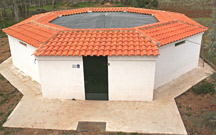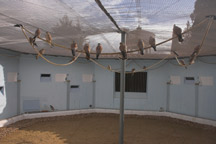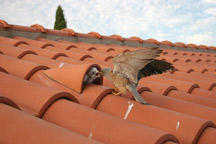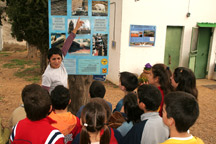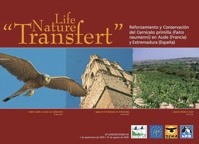Reinforcement and Conservation of the Lesser Kestrel (Falco naumanni)
in Aude, (France) and Extremadura (Spain).
3. Presentation of the principal actions
Reintroduction Programme
It is the first time that a programme for the reintroduction of the Lesser Kestrel is carried out in France. The French project benefits of the knowledge of DEMA as they have 15 years of experience in this type of activity in different areas in Spain.
The techniques of reintroduction have to be selected keeping in mind the tendency of the Lesser Kestrel to return to its birth place (phylopatric).
A method called “Ambiente de Colonia” (atmosphere of a colony) is used in the liberation of the birds. It is designed by DEMA and it has been carried out in practice in various places in Spain with excellent results. This method is based on a well known system called Hacking. However, it contains some modifications of great importance for the liberation of a colonial species like the Lesser Kestrel.
After 20 days of the birth of the chicks in DEMA´s breeding Centre they are put in an artificial nest. There they can be fed without them noticing any human presence. The nest is placed in the same cage or a room with various irrecoverable birds. Thus the chicks will not get isolated and remain in physical and visual contact with their own species. This creates a similar ambience to a wild colony and the contact with the mature birds helps retaining the adequate behaviour. The permanency in the place of liberation is longer and the natural drive towards the area of the new colony will be established and the possibility of return during the winter migration increases.
In LIFE Transfert, this work will be carried out in a period of four years (2006 – 2009). The place of reintroduction has to be situated in the surroundings of the Macizo de la Clape and the lowlands of Aude. The objective is to liberate 170 chicks during four years: fifty in 2006 and forty each year until 2009. The liberated chicks are marked with plastic (PVC) rings in order to be able to follow their movements when they become independent or return to the place of liberation. The first returns to the new colony in Aude are expected as well as the first nests for the spring of 2007. The objective is to establish a new colony with at least ten pairs before the end of the programme.
Breeding in Captivity
In order to carry out a programme of reintroduction is necessary that the chicks are in the right age when they are liberated. When the species in question is endangered like the Lesser Kestrel, the only solution for obtaining individuals with a certain age is to arrange the breeding in captivity.
DEMA has been exclusively dedicated to the breeding of the Lesser Kestrel since 16 years. All the pairs share a specially designed cage in order to create the atmosphere of an actual wild colony. DEMA was the first Spanish centre to use the colonial method, before that each pair had an isolated space of their own.
The colonial cage is designed to provide all the necessary for the breeding process and its observation, studies of behaviour and maintenance, all without bothering the species. The tranquillity is essential for the successful breeding.
Each pair is observed and its relation to the others studied during the breeding season. The individuals can be distinguished and controlled by the rings.
The birds can be observed through a glass from the hall without being seen. This makes arranging visits and environmental education easy while the birds do not get disturbed.
Within the LIFE Programme DEMA will provide the chicks that are to be introduced in Aude and functions also as a consultant with the centre of Millau (UFCS) in order to construct the first French breeding centre for the Leser Kestrel. In the future this new centre will carry out the reintroduction programmes.
Control of hunting grounds
The areas of Aude and Almendralejo are situated in the middle of regions that consist predominantly of vineyards (vine, olive trees, wastelands, low mountains…) The maintenance of these habitats is essentially important to birds feeding on small insects. These are species like for example the European Roller (Coracias garrulous), the Stone Curlew (Burhinus oedicnemus) and the Little Owl (Athene noctua). LPO (Ligue pour la Protection des Oiseaux, Aude) has already made a guide for the control of the Lesser Kestrel on the plain of Crau (region of Bouches-du-Rhône). DEMA and the LPO Aude use these results as a basis for the creation of a guide on the areas of Almendralejo and Aude. The objective is to put in action new means favouring the species. In order to do this information about the regimen of the species and its behaviour in the habitat has to be gathered as well as practical experience. To avoid the disappearance of open habitats LPO and ACPP (Associatión de Chasseurs et Propriétaires Pérpignanais) will also carry out controlling experiments in Aude (weeding the low mountain area and maintenance of wastelands).
Control of nesting sites
The main factors limiting the nesting of the Lesser Kestrel are the lack of adequate holes for nesting. In Spain over the 90 % of the species nests in urban zones. The restoration of old buildings reduces the availability of adequate holes and gaps. In the town of Almendralejo almost all the nesting pairs inhabit artificial nests installed in the church (Iglesia de la Purificación). All the other buildings where the Lesser Kestrel used to breed are now restored and inadequate for nesting.
The mutual sharing of experiences among the participators of the LIFE Programme will advance the control of the nesting sites in practice.
In order to start the programme in Aude it is necessary to construct a building that will serve as a breeding space for the new Lesser Kestrel colony. Also for the system of liberation (Hacking).
When it comes to the colony of Almendralejo, it has been noticed that several chicks have fallen off from the roof of the church before they actually start flying. This is probably due to the fact that most of the nests are situated close to the cornice. To avoid this in the future, DEMA will install new nests under the roof tiles and in the tower.
Informing and awareness of people
The Lesser Kestrel nests often in urban zones and it’s easy to observe. It doesn’t present any threat to small animals, not to mention farm yard or pet birds. It brings a touch of the wilderness in to urban environment and together with other similar wild species (for example the white Barn Owl (Tyto alba alba), the Stork (Ciconia ciconia) or the Swallow (Hirundo rustica) they reflect a well conserved biodiversity also in cities. An important part of the LIFE Programme is the informing of people in order to improve the general acknowledgement and approval of the species. This information is crucial to local functionaries that are in the position to affect directly on the conservation of the species. Diverse activities will be carried out in both enclaves, for example work shops with schools, conferences, expositions, lectures and presenting graphic material such as pamphlets, posters, stickers, monographs.





